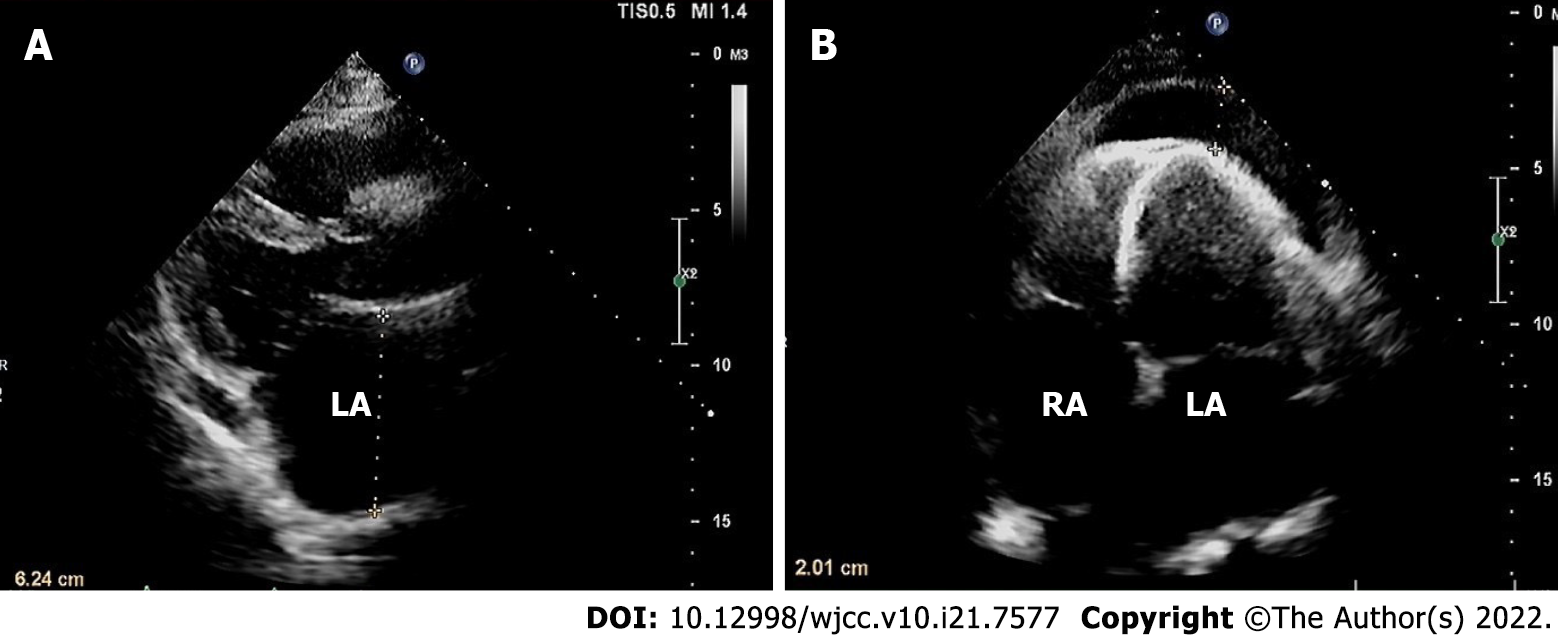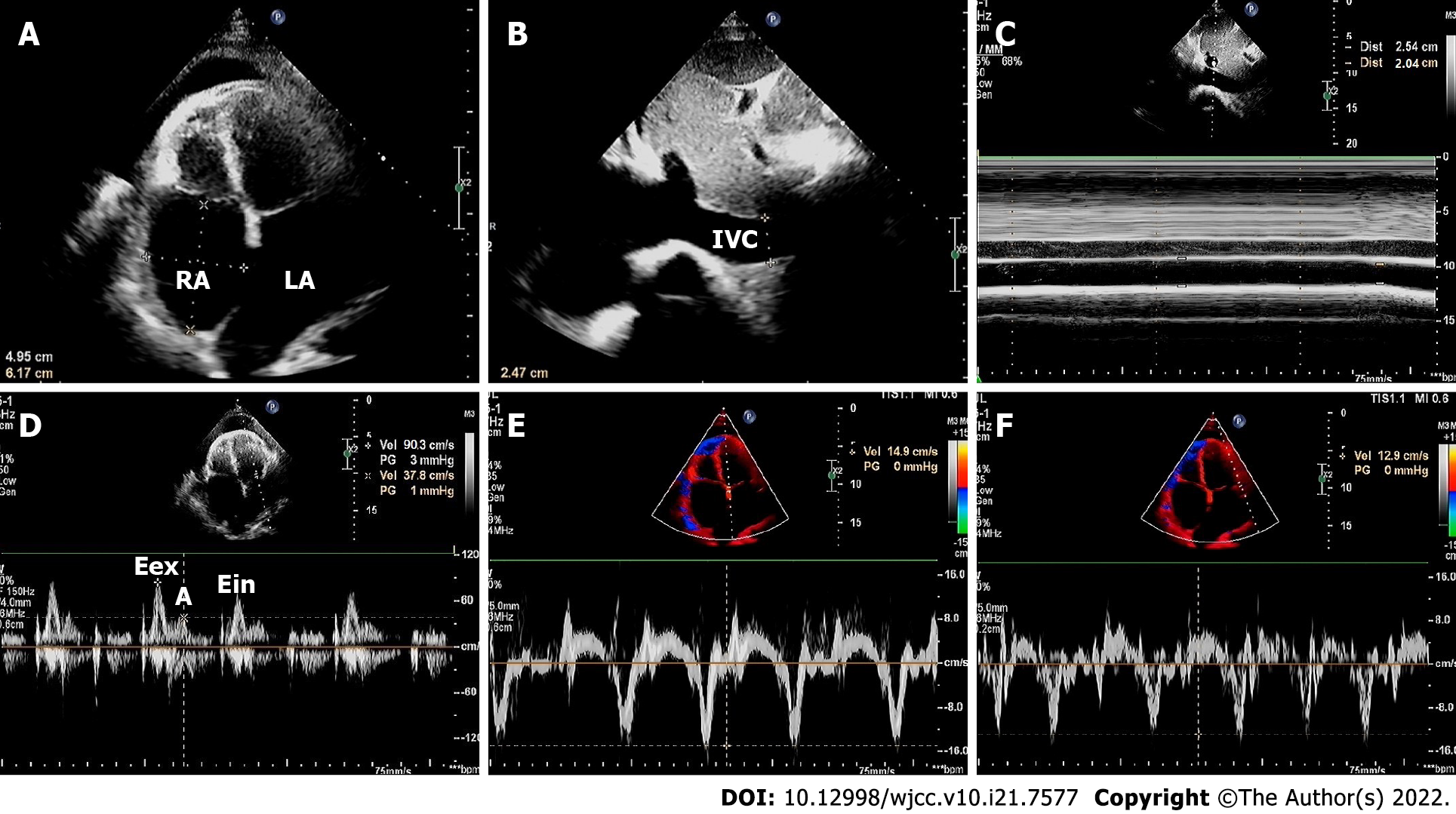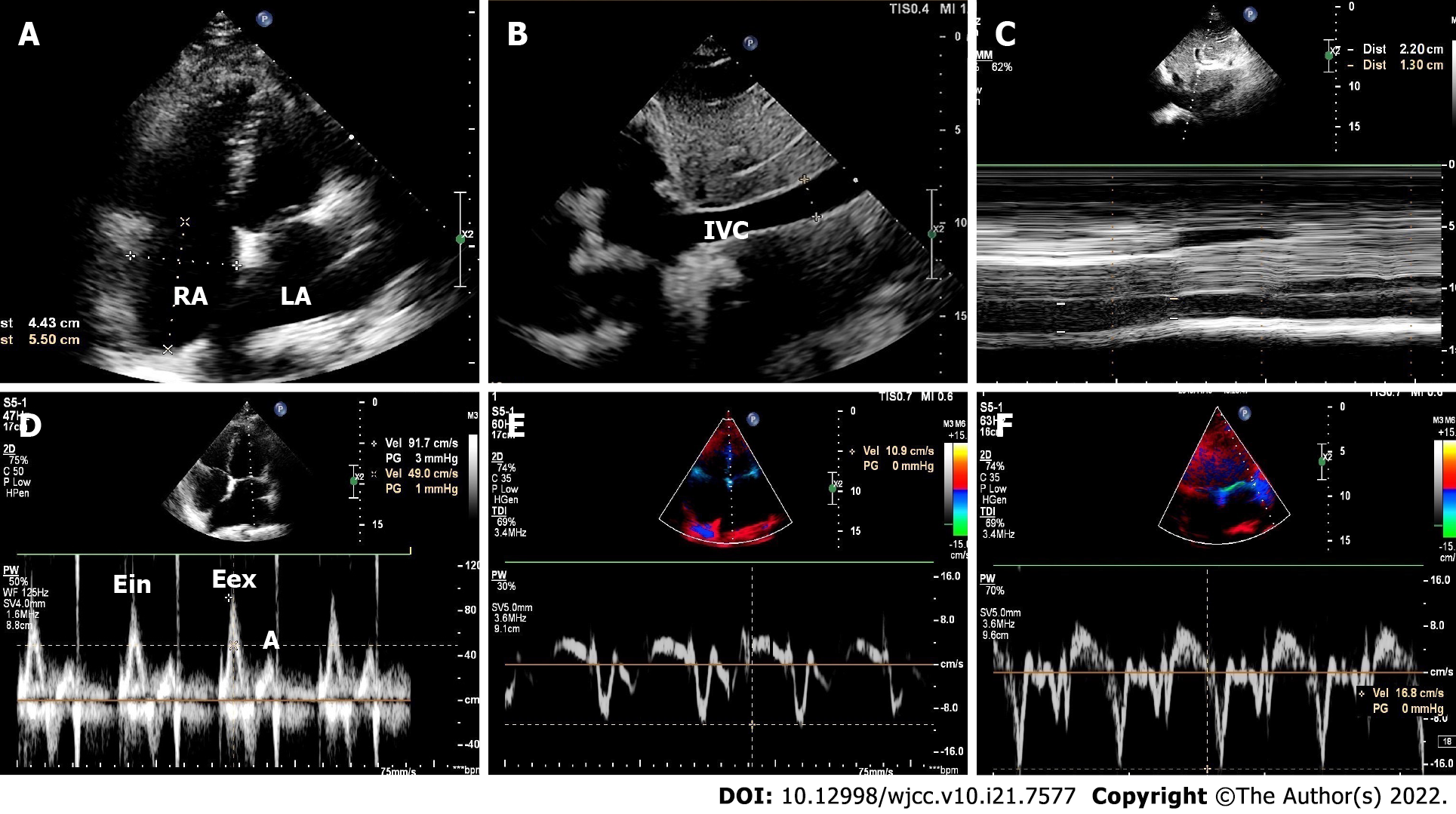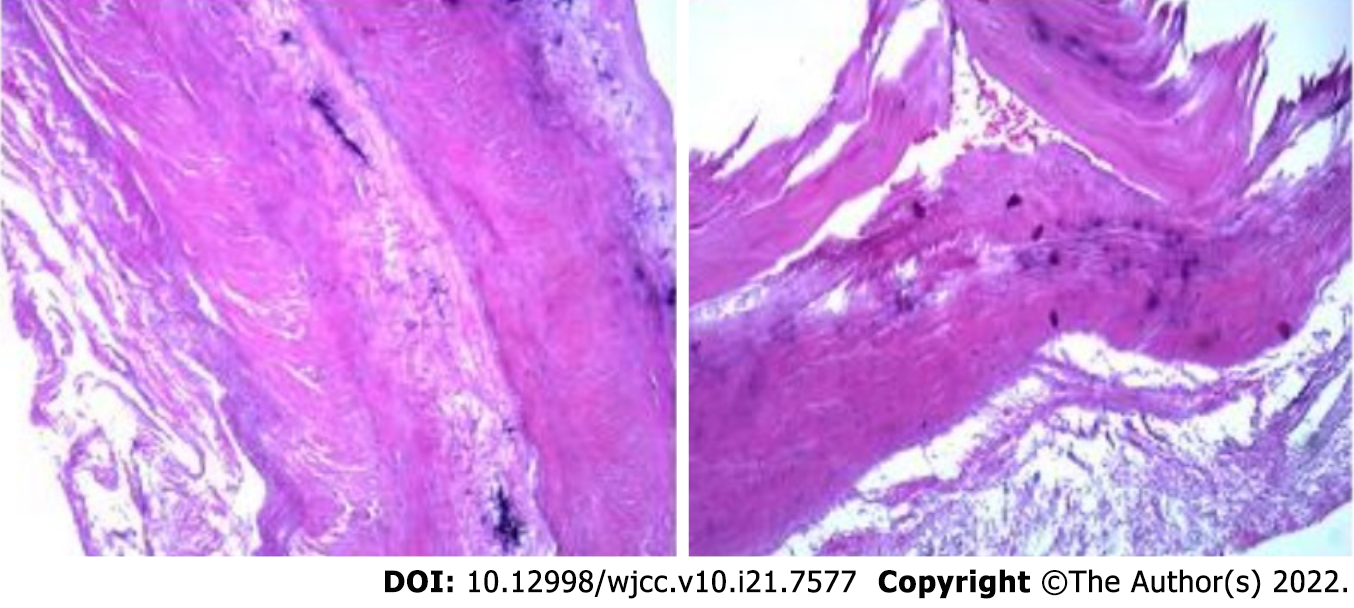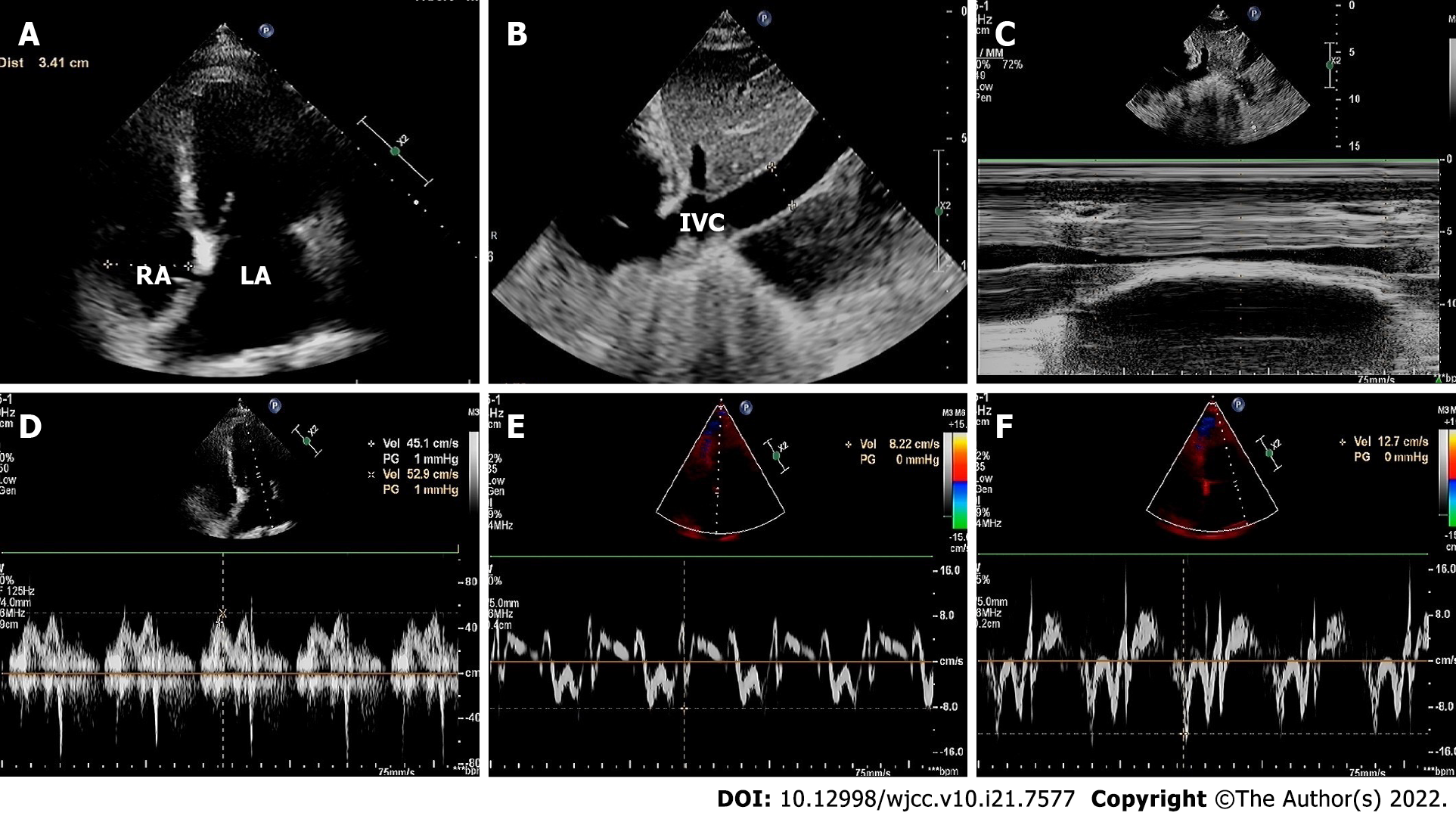Copyright
©The Author(s) 2022.
World J Clin Cases. Jul 26, 2022; 10(21): 7577-7584
Published online Jul 26, 2022. doi: 10.12998/wjcc.v10.i21.7577
Published online Jul 26, 2022. doi: 10.12998/wjcc.v10.i21.7577
Figure 1 Echocardiographic examinations before pericardiocentesis.
A: The left atrium was significantly enlarged, with an anteroposterior diameter of 6.2 cm; B: The diameters of the left and right atrium were 5.9 cm × 6.1 cm and 5.0 cm × 6.0 cm, respectively. A moderate pericardial effusion that was predominantly along the apical wall, measuring up to 2.0 cm. LA: Left atrium; RA: Right atrium.
Figure 2 Echocardiographic examinations after pericardiocentesis.
A: Right atrial (50 mm × 62 mm) and left atrial (61 mm × 61 mm) enlargement, increased pericardial thickness, and pericardial effusion that was located predominantly along the apical wall (measuring up to 1.2 cm); B and C: Dilated inferior vena cava (up to 2.5 cm) almost without any aspiratory variation (20%), indicating an elevated right atrial pressure of approximately 20 mmHg; D: Pulsed wave doppler of the mitral valve showed that the peak mitral E and A inflow velocity were 90 cm/s and 38 cm/s, respectively. The E/A ratio was > 2, indicating restricted mitral inflow velocity. Respiratory variation in the peak mitral E inflow velocity was 28% (peak E velocity during expiration and inspiration were 90 cm/s and 65 cm/s, respectively); E and F: Tissue Doppler imaging showed “annulus reversus” with the lateral mitral e’ velocity (12.9 cm/s) abnormally lower than the medial mitral e’ velocity (14.9 cm/s). IVC: Inferior vena cava; LA: Left atrium; RA: Right atrium.
Figure 3 The follow-up echocardiography 1 wk after pericardectomy.
A: The diameters of the left and right atriam were 5.4 cm × 6.1 cm and 4.4 cm × 5.5 cm, respectively. The localized pericardial effusion disappeared; B and C: The diameter of the inferior vena cava (2.2 cm) and aspiratory variation were still lower than 50% (41%). The calculated right atrial pressure was lower than that before pericardectomy (12 mmHg); D: Pulsed-wave Doppler of the mitral valve showed that the peak mitral E and A inflow velocities were 92 cm/s and 49 cm/s, respectively. Respiratory variation in the peak mitral inflow velocity (E) was 15% (peak E velocity during expiration and inspiration were 92 cm/s and 78 cm/s, respectively); E and F: Tissue Doppler imaging revealed that the medial mitral e’ velocity (10.9 cm/s) was lower than the lateral mitral e’ velocity (16.8 cm/s). IVC: Inferior vena cava; LA: Left atrium; RA: Right atrium.
Figure 4 Histologic examination performed on the pericardial tissue revealed increased thickening with the proliferation of collagen fibers, hyaline degeneration, and calcification.
Figure 5 The follow-up echocardiography 1 mo after discharge.
A: The size of the left atrium was smaller than before (5.3 cm × 5.5 cm), and the right atrium was approximately normal (3.4 cm × 4.2 cm) in the absence of pericardial effusion; B and C: The diameter of the inferior vena cava (1.9 cm) and aspiratory variation (greater than 50%) were normalized, based on which the calculated right atrial pressure was within the normal range, approximately 5 mmHg; D: Pulsed-wave Doppler of the mitral valve showed that the peak mitral E and A inflow velocities were 45 cm/s and 53 cm/s, respectively. The E/A ratio was < 1; E and F: Tissue Doppler imaging showed that the medial mitral e’ velocity (8.2 cm/s) was lower than the lateral mitral e’ velocity (12.7 cm/s). IVC: Inferior vena cava; LA: Left atrium; RA: Right atrium.
- Citation: Chen JL, Mei DE, Yu CG, Zhao ZY. Pseudomonas aeruginosa-related effusive-constrictive pericarditis diagnosed with echocardiography: A case report. World J Clin Cases 2022; 10(21): 7577-7584
- URL: https://www.wjgnet.com/2307-8960/full/v10/i21/7577.htm
- DOI: https://dx.doi.org/10.12998/wjcc.v10.i21.7577









